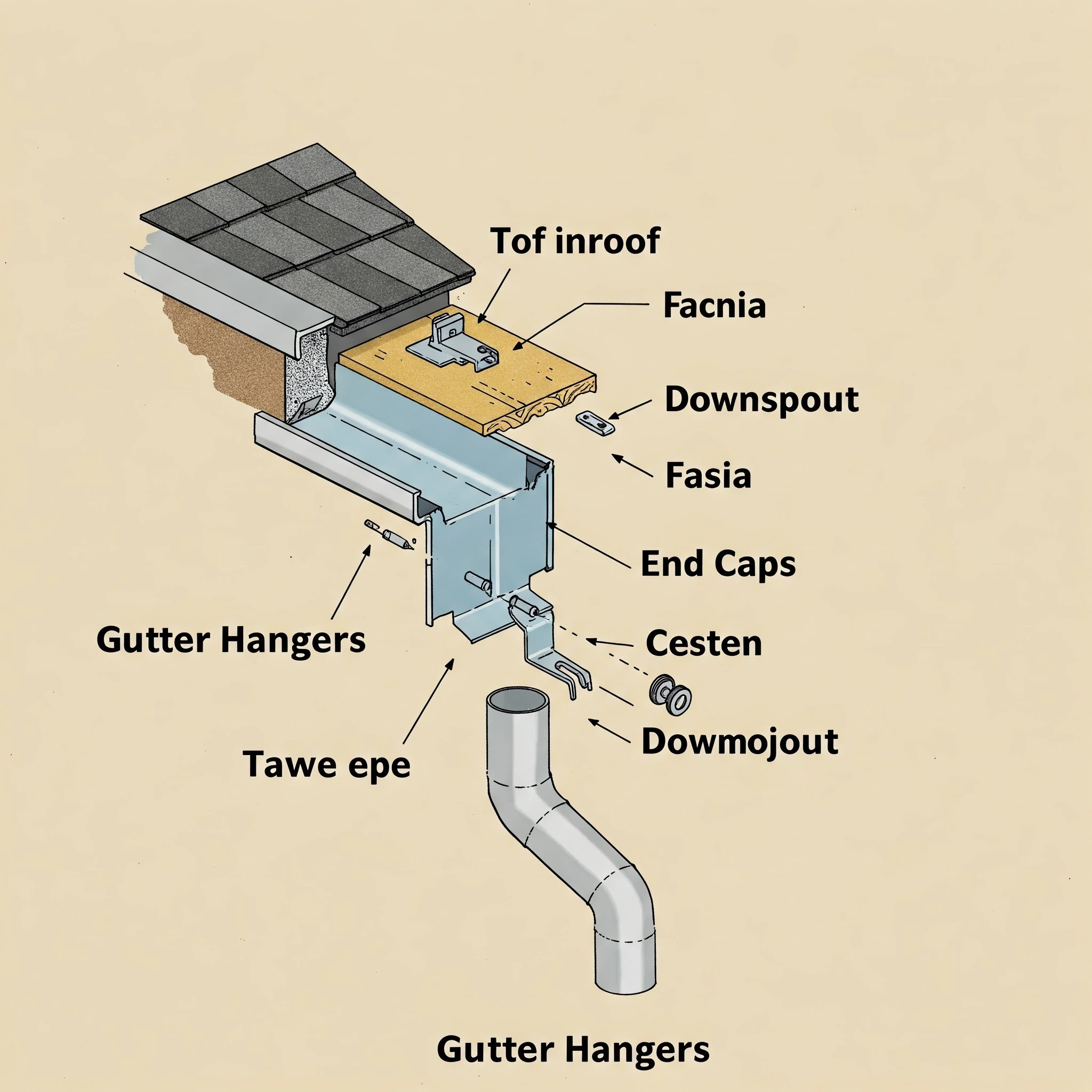Gutter Parts Explained: Your Complete Guide to Gutter Anatomy
Water Damage Worries? Understanding Your Gutter Parts is Key
Your gutter system is more than just a collection of pipes! It’s a crucial defense against water damage, and understanding the different gutter parts is key to its proper function. This guide is designed to help homeowners and DIY enthusiasts alike navigate the world of gutters. We’ll break down each component, from the fascia to the downspouts, explaining its role and how it contributes to the overall health of your home. Our goal is to demystify these essential gutter parts and empower you with the knowledge you need.
The Essential Gutter Components: Channels & Outlets
The primary job of your gutter system is to efficiently channel rainwater away from your home’s foundation. The main gutter channel is the horizontal trough that runs along the edge of your roof, collecting runoff. These channels are commonly made from various materials, each with its own benefits and drawbacks. Aluminum gutter parts are popular for their affordability and rust-resistance, while vinyl offers a lightweight and easy-to-install option. Copper provides a classic aesthetic and exceptional durability, but comes at a higher cost. Steel offers strength but can be susceptible to rust if not properly coated.
Directly connected to your gutter channel are the outlets, often overlooked but equally important. These are openings, usually circular, that allow water to flow efficiently into the downspouts. They are generally made of the same materials as the gutter channels themselves, ensuring a seamless and watertight connection. Choosing the right materials for both your gutter channels and outlets is crucial for a long-lasting and effective gutter system.
Supporting the System: Fascia Boards & Gutter Hangers
The longevity and effectiveness of your gutter parts rely heavily on the support system beneath. The fascia board is the flat, horizontal board that runs along the eaves of your roof, providing a crucial surface for attaching the gutters. A healthy and sturdy fascia is vital for gutter stability, ensuring that the channels remain properly aligned and can handle the weight of rainwater and debris. Common issues such as rot and insect damage can weaken the fascia, leading to sagging or even detached gutters. Regular inspection and prompt repairs are essential to maintain the integrity of your gutter system.
Gutter hangers are the hardware that physically connects the gutters to the fascia. Two common types are spike and ferrule hangers, which are budget-friendly but can weaken the fascia over time, and hidden hangers, which offer a more secure and aesthetically pleasing installation. Regardless of the type you choose, proper hanger spacing is key to optimal support, preventing sagging and ensuring that your gutters can efficiently channel water away from your home.
Directing Water Away: Downspouts & Extensions
Downspouts are the vital vertical pipes that channel rainwater from your gutters away from your home’s foundation. These gutter parts come in various shapes and sizes and should be strategically placed to ensure proper water drainage.
Downspout extensions further direct water away from the foundation, preventing potential water damage. Options include simple splash blocks and more adaptable flexible extensions. Correct extension length and direction are essential, as directing water adequately away from the foundation is crucial for protecting your home’s structural integrity.
Protecting Your Gutters: End Caps & Gutter Guards
To ensure your gutter parts function correctly, it’s important to protect them from damage and debris. End caps seal the ends of your gutters, preventing water from escaping and directing it towards the downspouts. Using quality end caps is essential for a watertight system and preventing leaks that can damage your fascia or siding.
Gutter guards are another essential element, preventing leaves, twigs, and other debris from clogging your gutters. This reduces the need for frequent cleaning and ensures proper water flow. Various types of gutter guards are available, including mesh screens, foam inserts, and brush guards, each with its own advantages and disadvantages.
Be Your Own Gutter Expert: A Proactive Approach to Water Protection
Understanding your gutter system doesn’t have to be daunting! By familiarizing yourself with the essential gutter parts – from the channels and downspouts to the fascia and hangers – you can take proactive steps to protect your home from water damage. Remember to inspect and clean your gutters regularly to ensure optimal performance. A well-maintained gutter system is a vital investment in your home’s long-term health and value.
Enjoy a Spotless Home – Without Lifting a Finger!
Let our expert cleaners handle the hard work while you relax in a fresh, tidy space. Schedule your professional house cleaning in CR Maids today and experience effortless cleanliness by booking your appointment here.
Frequently Asked Questions
1. How often do you clean gutters?
Twice yearly (spring/fall) is typical. Clean more often if you have many trees to avoid clogs and water damage.
2. Signs gutters need repair?
Look for sagging, leaks, cracks, rust, or detached downspouts. Address problems quickly to prevent further, costly damage.
3. DIY gutter installation?
Possible if skilled, but consider safety and complexity. Professional installation often ensures proper function and avoids problems.
4. What are gutter guards?
Guards prevent debris, reducing cleaning needs, especially with trees. Research guard types to find the right fit for your home.
5. Consequences of neglecting gutters?
Neglect leads to water damage, pests, mold, and ice dams. Regular maintenance prevents costly repairs and protects your home.
Key Takeaways
- Essential parts: Gutters, downspouts, fascia boards, hangers, end caps, and gutter guards all work together to manage rainwater runoff.
- Each part is vital: Every gutter part has a specific function, from channeling water to providing structural support, protecting your home.
- Understand your system: Knowing how your gutters work enables you to identify problems early and maintain them effectively.
- Maintain regularly: Inspect for damage/debris and clean gutters at least twice yearly for optimal performance.

